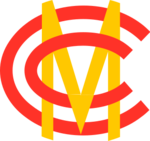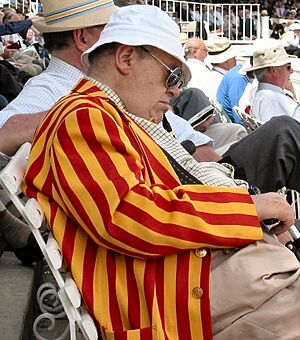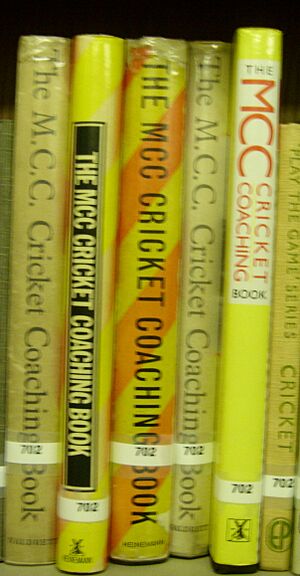Marylebone Cricket Club facts for kids
 |
|
| Team information | |
|---|---|
| City | St John's Wood, London, England |
| Founded | 1787 |
| Home ground | Lord's Cricket Ground |
The Marylebone Cricket Club (MCC) is a very famous cricket club that started in 1787. It owns and is based at Lord's Cricket Ground in London, England, since 1814. For a long time, from 1788 to 1989, the MCC was in charge of all cricket rules. It still has a lot of influence around the world.
In 1788, the MCC took over writing the Laws of Cricket. They published a new version that year. Today, the International Cricket Council (ICC) decides on changes to these Laws. However, the MCC still owns the copyright. When the ICC was created in 1909, the MCC's secretary managed it. The MCC president automatically became the ICC chairman until 1989.
For most of the 1900s, the MCC organized international tours for the England cricket team. This started with a tour to Australia in 1903–04 and ended with a tour to India in 1976–77. On these tours, the England team played non-international matches under the MCC's name. In 1993, the MCC handed over its main management duties to the ICC and the Test and County Cricket Board (TCCB).
MCC teams are special because they don't play in regular competitions. However, their matches against other top teams are always considered "first-class."
The club's current president is Mervyn King, Baron King of Lothbury. He used to be the head of the Bank of England. He became president on October 1, 2024, taking over from Mark Nicholas.
Contents
How the MCC Started and What It Does
The Club's Early Days
The MCC began as a "gentlemen's club" in the 1700s. Many of its early members were also part of other cricket clubs. One of these was the White Conduit Club in Islington, London. This club was for "gentlemen" only, but they did hire professional players. One of these players was Thomas Lord. He was known for his business skills and his bowling.
The White Conduit gentlemen didn't like that the public could watch their matches. They wanted a more private place to play. So, two important members, George Finch, 9th Earl of Winchilsea and Charles Lennox, 4th Duke of Richmond, asked Thomas Lord to find a new ground. They promised to cover any money he might lose.
Finding a New Home for Cricket
Thomas Lord found some land in Marylebone. He leased it in 1787. The new ground was first called the New Cricket Ground. By July 1787, it was known as Lord's. Because it was in Marylebone, the White Conduit members who moved there decided to call themselves the "Mary-le-bone Club." The exact date the MCC was founded is not known, but it was likely in the spring or summer of 1787.
The first known match at Lord's was played on May 21, 1787. It was advertised as a "grand match" between noblemen from the White Conduit Club and gentlemen from Middlesex. The first match featuring the Mary-le-bone Club itself was on July 30, 1787, against the Islington Club.
Lord's Cricket Grounds Through History
There have been three different Lord's grounds. Thomas Lord leased the first one, called Lord's Old Ground, in 1787. The MCC played there until 1810. Lord moved the turf (the grass) from this ground because the rent became too high. The Old Ground is now where Dorset Square is located. A special plaque was put there in 2006 to remember its history.
Lord then leased a second ground in 1808. This new ground was ready in 1809. It is now known as Lord's Middle Ground. However, cricket was not very popular at this time because of the Napoleonic Wars. Only a few matches were played there, and the MCC only played three games in 1813.
Lord had to leave the Middle Ground because a canal was being built through it. So, in 1814, he leased a third plot of land nearby. He moved his turf again, and this third ground is the Lord's Cricket Ground we know today. The MCC has been playing there for over 200 years!
Other Places MCC Has Played
From 1996 to 2008, the MCC also played some important matches against touring teams at other grounds. These included:
- Denis Compton Oval in Hertfordshire (1996–1999)
- University Parks in Oxford (2000)
- Savile Park in Castleford (2000)
- Arundel Castle Cricket Ground in Sussex (2001–2007)
- Queen's Park, Chesterfield in Derbyshire (2002)
- The Racecourse in Durham (2007–2008)
The Laws of Cricket
The MCC is still the group in charge of the Laws of Cricket. They also own the copyright to these rules. A special committee at the MCC discusses and writes down any changes to the Laws. Then, the main committee votes on these changes.
Becoming an MCC Member
The MCC has 18,000 full members and 5,000 associate members. Members can vote on club matters. They can also use the Pavilion and other stands at Lord's Cricket Ground to watch all matches played there.
For a long time, the club only allowed men to be members. This changed in 1998. Rachael Heyhoe Flint helped lead the effort to allow women to join. In September 1998, 70% of members voted to allow women. This ended 212 years of male-only membership. Ten honorary life members, including Heyhoe Flint, were immediately welcomed. Before this, The Queen, who is the club's patron, was the only woman allowed in the Pavilion during play (besides staff). In February 1999, five women were invited to become playing members.
To join the waiting list for membership, you need three current members to vote for you. You also need a sponsor from a special list of MCC sponsors. Because many people want to join, there is a very long waiting list. It currently takes about 27 years to become a full member! However, there are faster ways to join, like becoming a playing member.
The club also allows a certain number of people to join early each year. Famous people like Mick Jagger and former Prime Minister Lady May have been invited to join this way. The MCC also gives honorary memberships to people who have had great cricket careers, including women like Charlotte Edwards.
MCC Matches and Coaching
Playing Matches
MCC men's and women's teams play matches throughout the spring and summer. They play against teams from universities, schools, the Armed Forces, and special invitational teams. The men's team travels internationally four times a year, and the women's team tours every other year.
Cricket Coaching
The MCC has always been very involved in teaching cricket. The club has a head coach who runs a large program. This includes an indoor cricket school and coaches who work in England and around the world. The MCC traditionally publishes the MCC Cricket Coaching Book, which is like a guide for cricket skills. They also run training programs for young cricketers at their Lord's Indoor Centre. The club continues to tour England, playing matches against various schools. This tradition has been going on since the 1800s. The MCC also has other sports interests, like real tennis and squash courts at Lord's. They also have societies for golf, chess, bridge, and backgammon.
MCC Club Colours
From the early 1900s, the MCC organized the England cricket team. Outside of Test matches, the touring England team officially played as "MCC" until the 1976/77 tour of India. The England touring team wore the MCC's special red and yellow stripes for the last time on their tour to New Zealand in 1996/97.
No one is completely sure how the MCC got its famous scarlet and gold colours, sometimes called "egg and bacon." One idea is that they got them from a gin company whose chairman helped the club. Another, more likely, idea is that the MCC borrowed its colours from the racing colours of one of its founding members, Charles Lennox, 4th Duke of Richmond.
MCC's Legal Status
Before 2013, the MCC was a private club without a formal legal structure. This meant it couldn't own property like Lord's Cricket Ground in its own name. It also couldn't sue or be sued directly. If there were financial problems, the members themselves could be responsible for the costs.
To fix this, the club asked The Queen to grant them a Royal Charter. This was approved in December 2012. With the Royal Charter, the MCC became a formal legal organization. Now, it can own its assets, including Lord's Cricket Ground, in its own name. This also means that individual members are no longer personally responsible if the club faces serious financial trouble.
MCC Universities
Since 2005, the MCC has helped fund six university cricket academies called the MCC Universities (MCCUs). These academies were previously funded by the England and Wales Cricket Board (ECB). They are based at universities like Cambridge, Cardiff, and Oxford.
From 2012, all six MCCUs were given "first-class" status. This means they played important matches against professional county teams at the start of each season. In 2018, the MCC and ECB announced that the ECB would take over funding these university centers again from 2020. The university teams still use the MCC University names.
Leaders of the Club
The President's Role
The President of the MCC serves for one year. Usually, they cannot serve two years in a row. However, during World War I and World War II, some presidents stayed longer. For example, Lord Hawke was president for five years during World War I.
In the past, many MCC presidents were from noble families. But in recent years, the club has had presidents who were professional cricketers, like Tom Graveney and Mike Gatting. In 2020, Kumar Sangakkara became the MCC's first president who was not British.
Each President chooses their successor at the club's Annual General Meeting. The club chairman and treasurer serve for three years and can serve multiple terms. The Secretary and Chief Executive is the club's top employee.
The club's committee includes these officers, plus the heads of other committees, and twelve elected members. Elected committee members serve for three years.
Club Secretaries
The MCC first hired a Club Secretary in 1822. In 2000, the title changed to Secretary and Chief Executive. Here are some of the people who have held this important role:
- Benjamin Aislabie (1822–1842)
- Roger Kynaston (1842–1858)
- Alfred Baillie (1858–1863)
- Robert Allan Fitzgerald (1863–1876)
- Henry Perkins (1876–1898)
- Sir Francis Lacey (1898–1926)
- William Findlay (1926–1936)
- Rowan Rait Kerr (1936–1952)
- Ronnie Aird (1952–1962)
- Billy Griffith (1962–1974)
- Jack Bailey (1974–1987)
- John Stephenson (1987–1994)
- Roger Knight (1994–2006)
- Keith Bradshaw (2006–2011)
- Derek Brewer (2011–2017)
- Guy Lavender (2017–2024)
- Robert Lawson (2025–)
See also
 In Spanish: Marylebone Cricket Club para niños
In Spanish: Marylebone Cricket Club para niños




